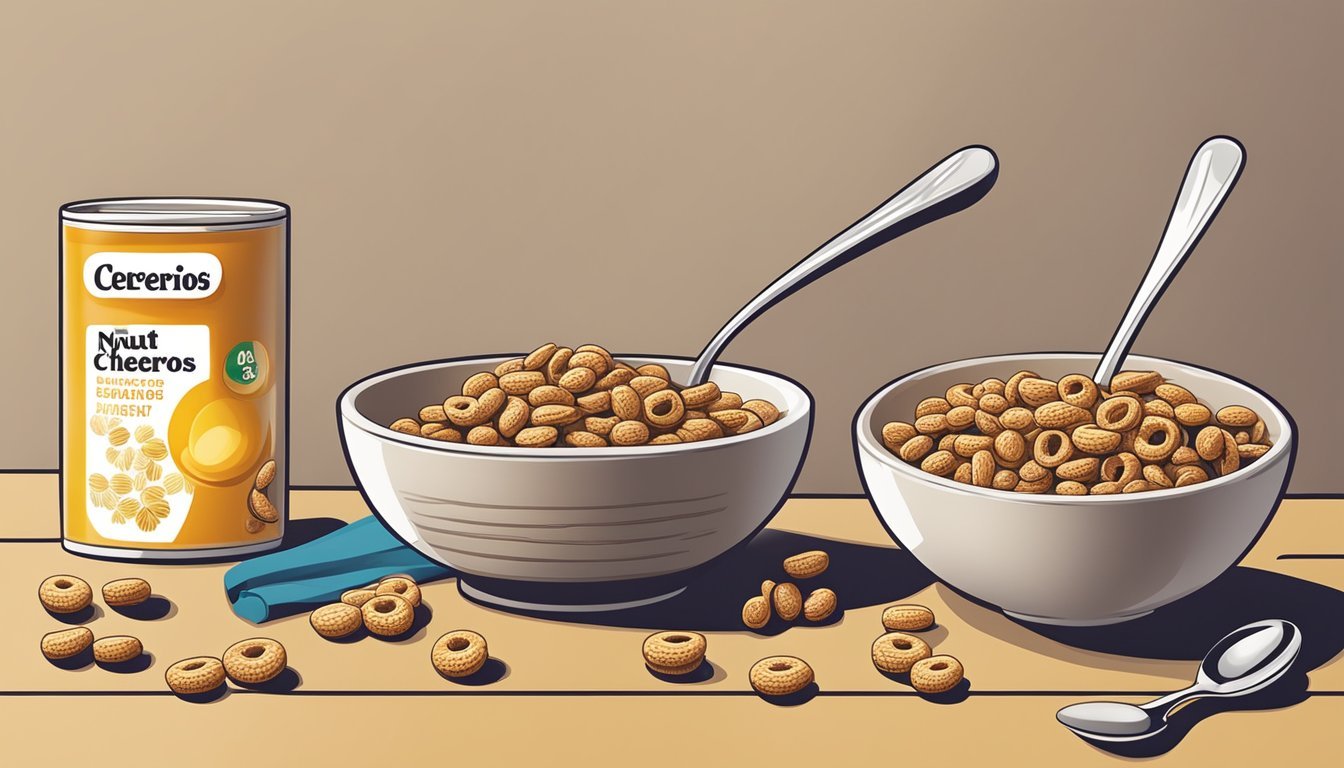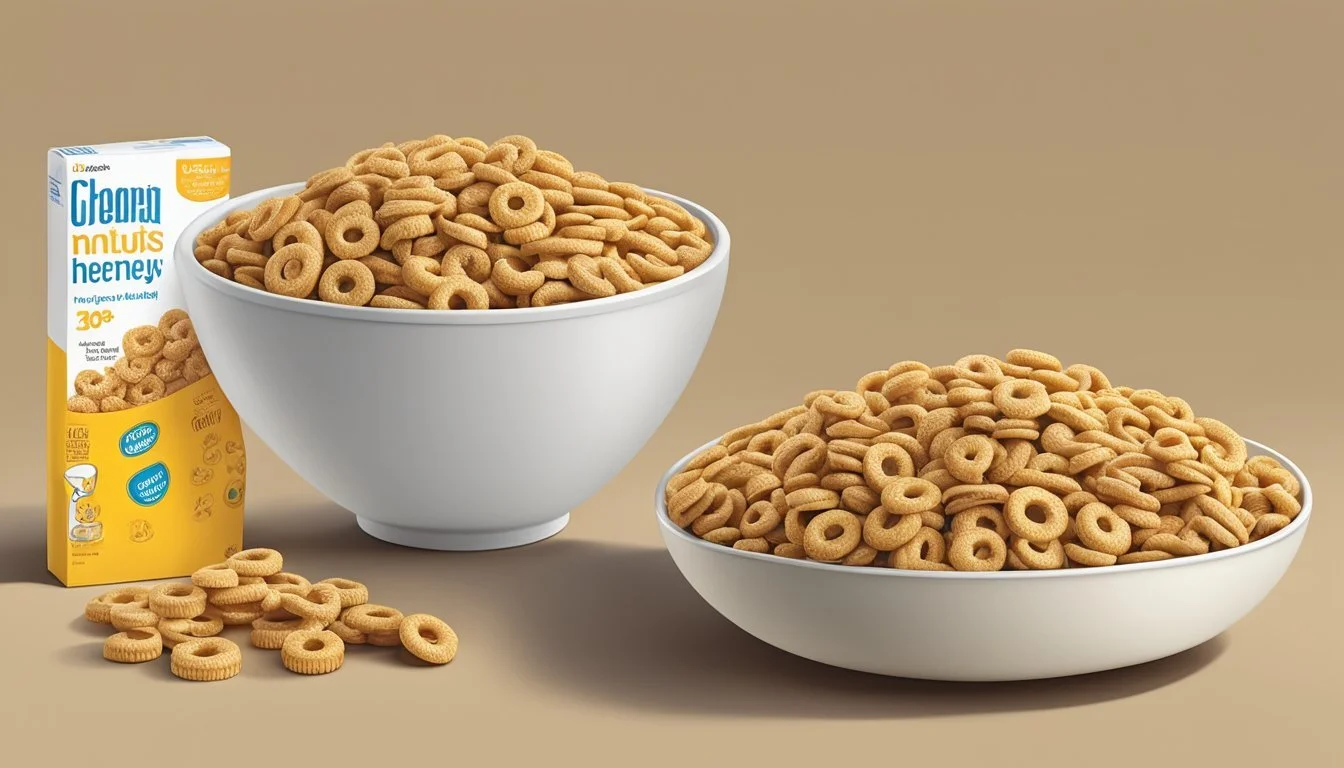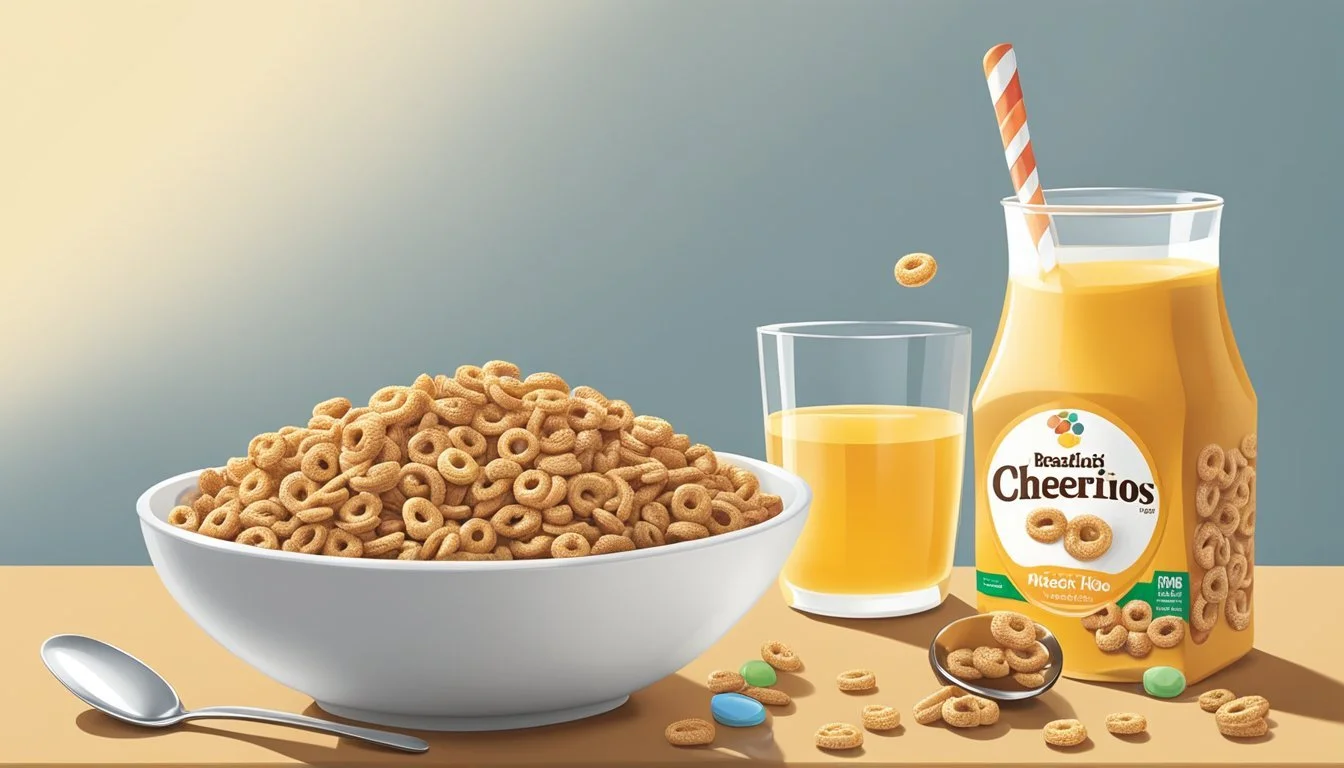All-Bran vs Honey Nut Cheerios
A Nutritional Comparison
This Article is Part of Our Breakfast Cereal Guide with Details on All-Bran Nutrition and Honey Nut Cheerios Nutrition
When it comes to choosing a healthy breakfast cereal, All-Bran and Honey Nut Cheerios are two popular options that often come up for comparison. Both cereals have unique nutritional profiles that may appeal to different dietary needs. For those prioritizing fiber intake, All-Bran clearly stands out, as it is well-known for its high fiber content, which is essential for digestive health.
On the other hand, Honey Nut Cheerios are typically favored for their taste and lower sodium content. With only 136 milligrams of sodium per serving, it is a good choice for individuals on a low-sodium diet. However, it’s important to note that Honey Nut Cheerios contain more complex carbohydrates per serving compared to All-Bran, which may be a consideration for those monitoring their carbohydrate intake.
Understanding the nutritional differences between these two cereals can help you make a more informed decision for your breakfast routine. Whether you prioritize fiber or taste, each cereal has something to offer. Considering these factors can ensure that you select the cereal that best fits your dietary preferences and health goals.
Overview of All-Bran and Honey Nut Cheerios
All-Bran and Honey Nut Cheerios have significant histories and widespread recognition. Each has unique attributes and marketing strategies, making them staples in grocery stores as name-brand cereals.
Historical Development
All-Bran, produced by Kellogg's, was launched in the early 20th century. It was one of the first cereals to emphasize high fiber content, aiming to promote digestive health.
Honey Nut Cheerios, introduced by General Mills in 1979, added honey and almond flavoring to the original Cheerios formula. This made it popular for its sweeter taste compared to the plain version.
Brand Recognition and Popularity
All-Bran is well known for its health benefits, particularly its fiber content. It appeals to health-conscious consumers looking for digestive benefits.
Honey Nut Cheerios has become a household staple, appreciated for its sweet flavor profile. Its widespread marketing campaigns and branded mascot, the Honey Nut Cheerios bee, have helped it remain a favorite among both children and adults.
Nutritional Comparisons
When comparing All-Bran and Honey Nut Cheerios, several key nutritional aspects come into focus. These include fiber, protein, sugar, fat, vitamins, minerals, and caloric values.
Fiber and Protein Content
All-Bran is particularly known for its high fiber content due to its use of wheat bran. It provides around 10 grams of fiber per serving, making it an excellent choice for digestive health. The fiber mostly comes from whole grains, which benefit the cardiovascular system.
Honey Nut Cheerios, on the other hand, contains 3 grams of fiber per serving. Its fiber content primarily derives from whole grain oats but is significantly lower than that of All-Bran. In terms of protein, both cereals provide approximately 3 grams of protein per serving, contributing to a balanced diet and muscle maintenance.
Sugar and Fat Analysis
Sugar content is a major differentiating factor between these cereals. Honey Nut Cheerios has a high sugar content with around 12 grams of sugar per serving, which includes ingredients like cane sugar and corn syrup. This makes it a sweeter, more palatable option for many but less ideal for those monitoring their sugar intake.
All-Bran contains significantly less sugar, with only 5 grams of sugar per serving. This lower sugar content makes it a better choice for those aiming to reduce sugar consumption.
In terms of fat, both cereals are relatively low. Honey Nut Cheerios contains about 1 gram of fat per serving, while All-Bran contains 1.5 grams of fat per serving. The fat content in both is minimal and doesn't significantly impact their nutritional profiles.
Vitamins and Minerals Content
Both cereals are fortified with essential vitamins and minerals, supporting a range of bodily functions. Honey Nut Cheerios includes higher amounts of vitamins such as vitamin C, vitamin B12, and zinc. These contribute to immune function and overall health.
All-Bran, while not as rich in vitamins, provides substantial amounts of iron and calcium. Iron is crucial for oxygen transport in the blood, and calcium supports bone health. Both cereals contribute beneficial nutrients but differ in their specific vitamin and mineral profiles.
Calorific Values
Caloric content is crucial for those tracking their energy intake. Honey Nut Cheerios has approximately 110 calories per serving. This moderate caloric content makes it suitable for those looking to manage their weight without feeling deprived.
All-Bran has a higher caloric value, with around 150 calories per serving. These additional calories can be attributed to the higher fiber content, which adds to the cereal's satiety factor. Both options present different caloric benefits depending on one’s dietary goals.
Health Benefits and Concerns
When choosing between All-Bran and Honey Nut Cheerios, it's essential to consider their impact on weight management, heart health, blood sugar control, and digestive health.
Weight Management
All-Bran is a preferred option for those aiming for weight loss due to its high fiber content. A serving provides a significant amount of dietary fiber, promoting a feeling of fullness and reducing overall calorie intake.
On the other hand, Honey Nut Cheerios contain more sugar, which might hinder weight loss efforts. While they also provide fiber, the added sugars can contribute to higher calorie consumption. Incorporating All-Bran into a healthy breakfast routine can aid in controlling appetite and supporting weight management goals.
Heart Health
Honey Nut Cheerios are marketed for their potential to lower cholesterol levels. The whole-grain oats in these cereals contain soluble fiber, specifically beta-glucan, which can help reduce LDL cholesterol.
All-Bran also contributes to heart health with its high fiber content, particularly from wheat bran. High fiber intake is associated with reduced risk of heart disease. Choosing cereals rich in soluble fiber and low in added sugars is vital for maintaining heart health. Including oat bran and bran flakes in the diet can be beneficial for cholesterol management.
Blood Sugar Control
All-Bran is an excellent choice for blood sugar control due to its low glycemic index. The fiber in All-Bran slows down carbohydrate absorption, leading to more stable blood sugar levels. This makes it a suitable option for individuals managing diabetes.
Honey Nut Cheerios contain higher amounts of sugar and have a moderate glycemic index. While they provide whole grains, the added sugars can cause more significant spikes in blood sugar levels. Opting for All-Bran can help achieve better glycemic control and prevent sudden blood sugar changes.
Digestive Health
Both All-Bran and Honey Nut Cheerios offer digestive benefits, but All-Bran stands out due to its higher fiber content. The wheat bran in All-Bran promotes regular bowel movements and alleviates constipation.
Honey Nut Cheerios also contain fiber, but in smaller amounts compared to All-Bran. Consuming cereals high in fiber is crucial for maintaining digestive health. Regular intake of fiber-rich foods like All-Bran can support a healthy digestive system and prevent various gastrointestinal issues.
Ingredient Analysis
This section examines the primary ingredients of All-Bran and Honey Nut Cheerios, focusing on their implications for nutrition and health. It covers whole grains and bran content, sweeteners and flavorings, and preservatives and additives.
Whole Grains and Bran
All-Bran's main ingredient is wheat bran, a rich source of dietary fiber. Wheat bran is known for its benefits in promoting digestive health and providing essential nutrients such as magnesium and iron.
Honey Nut Cheerios primarily use whole grain oats, an ingredient recognized for heart health benefits. Whole grain oats contribute to a good intake of dietary fiber and essential vitamins and minerals. Additionally, Honey Nut Cheerios may include other grains such as corn and rice to enhance texture and flavor profiles.
Sweeteners and Flavorings
Honey Nut Cheerios utilize honey, sugar, and molasses as primary sweeteners. Honey offers natural sweetness but contributes to the overall sugar content. Molasses adds a rich flavor and some micronutrients, but it also increases sugar levels.
All-Bran does not rely heavily on sweeteners, mainly focusing on its natural bran flavor. This cereal is typically lower in added sugars, making it a preferable option for those monitoring their sugar intake. Additionally, both cereals may use natural flavors to enhance taste without adding excessive calories.
Preservatives and Additives
Honey Nut Cheerios may contain preservatives such as tocopherols (a form of Vitamin E) to maintain freshness. These ingredients help in extending shelf life while preserving the cereal's quality.
All-Bran generally has fewer preservatives but may include some to ensure the product remains fresh over time. Common additives might include vitamins and minerals to enrich the cereal, compensating for potential losses during processing.
Neither cereal includes hydrogenated oils, which are undesirable due to their link to trans fats. Similarly, both All-Bran and Honey Nut Cheerios avoid artificial colors, aligning with a growing consumer preference for more natural food products.
Consumer Considerations
When choosing between All-Bran and Honey Nut Cheerios, consumers should take into account their taste and texture preferences, dietary restrictions, and economic factors. Each of these cereals offers distinct qualities that may align differently with individual needs and lifestyles.
Taste and Texture Preferences
All-Bran is known for its hearty and dense texture, often preferred by those looking for a substantial crunch. The flavor is robust and wheat-forward, catering to those who enjoy a more straightforward cereal taste.
Honey Nut Cheerios, on the other hand, offer a sweet, nutty flavor with a light, crispy texture. This cereal appeals to a broader audience, including children and adults who favor sweeter breakfast options.
Each cereal's distinctive texture and flavor profile play a crucial role in consumer preference.
Dietary Restrictions and Allergies
All-Bran is a high-fiber cereal made primarily from wheat, so it is not suitable for those with gluten allergies or sensitivities. It is also a good source of complex carbohydrates, with 7 grams per serving.
Honey Nut Cheerios contain no actual nuts, making them a decent choice for those with nut allergies. They provide 11.5 grams of complex carbohydrates per serving.
Neither of these cereals is typically organic, non-GMO, or vegan, but their ingredient transparency helps consumers make informed choices.
Economic Factors
When considering price, Honey Nut Cheerios often fall into a mid-range cost at grocery stores. They are widely marketed and frequently available in bulk or discounted packs, making them a cost-effective option for many families.
All-Bran might be slightly more expensive due to its niche market appeal and high-fiber content. Both cereals' prices can vary based on location, store promotions, and whether the purchase is in-store or online.
Comparing monthly grocery expenses can help determine the best financial choice for consistent consumption.
Each individual’s needs and values will play a critical role in which cereal is the more suitable choice for them.
Environmental and Ethical Considerations
Both Kellogg's and General Mills have taken steps to address environmental sustainability and ethical concerns in their cereal production processes. This involves focusing on sustainable sourcing, adhering to food safety regulations, and corporate social responsibility initiatives.
Sourcing and Sustainability
Kellogg's sources ingredients from global suppliers and has committed to sustainable agriculture practices. They have set goals to support farmers in using environmentally friendly methods and reducing water usage.
General Mills, the producer of Honey Nut Cheerios, emphasizes the use of non-GMO ingredients and aims to source 100% of their oats from farms that meet their sustainability standards by 2030. Both companies are working towards reducing their carbon footprint by implementing renewable energy sources in their production facilities.
Food Safety and Regulation Compliance
Ensuring food safety is paramount for both brands. Kellogg's adheres to strict safety regulations, which include rigorous testing for harmful substances like pesticides and GMOs in their All-Bran cereal. They follow both national and international food safety standards.
General Mills also conducts thorough testing to ensure their cereals, including Honey Nut Cheerios, are free from contaminants. They have faced some scrutiny over chemical residues in the past but are actively working to meet the FDA's new guidelines for "healthy" labeled foods, which emphasize lower sugar content and natural ingredients.
Corporate Social Responsibility
Corporate social responsibility (CSR) is integral to both Kellogg's and General Mills. Kellogg's has numerous initiatives aimed at alleviating hunger through food donations and supporting communities. They are also involved in global health and nutrition programs.
General Mills, on the other hand, has a strong focus on community engagement, environmental stewardship, and employee welfare. They support educational programs, environmental conservation efforts, and maintain transparency in their supply chains to ensure ethical practices.
By addressing these areas, both companies are not only working to provide healthier breakfast options but also aiming to make a positive impact on the broader community and the environment.
Alternative and Related Cereal Options
When considering alternatives to All-Bran and Honey Nut Cheerios, several healthier cereal varieties and popular comparisons can provide valuable insights.
Healthier Cereal Varieties
1. Nature's Path: This brand offers organic and gluten-free options, like their EnviroKidz line, which includes ingredients such as chia seeds. These cereals are praised for their nutritional benefits and commitment to organic foods.
2. Kashi Heart to Heart: Available in Honey Nut and Cinnamon flavors, Kashi Heart to Heart cereals are rich in heart-healthy ingredients, including whole grains and omega-3s.
3. Purely Elizabeth: This brand stands out for its granola options, which include nutrient-dense ingredients like ancient grains and superfoods. They are also gluten-free and often low in added sugars.
4. Ezekiel 4:9: Known as one of the healthiest cereals, Ezekiel 4:9 cereals are made from sprouted grains, providing a higher nutrient profile compared to traditional processed cereals.
Popular Cereal Comparisons
1. Honey Nut Cheerios vs. Raisin Nut Bran: General Mills manufactures both cereals, offering different nutritional benefits. Honey Nut Cheerios contains 110 calories per serving, while Raisin Nut Bran has 100 calories. Their protein content is identical at 3 grams per serving, but Raisin Nut Bran packs more fat with 2 grams compared to Honey Nut Cheerios' 1 gram.
2. All-Bran vs. Honey Nut Cheerios: All-Bran, a product of Kellogg’s, offers 7 grams of complex carbohydrates per serving, whereas Honey Nut Cheerios contain 11.5 grams. All-Bran focuses on dietary fiber, making it beneficial for digestive health, while Honey Nut Cheerios are known for their appealing taste and lower calorie count.
3. Shredded Wheat vs. Froot Loops: Shredded Wheat offers a whole grain, fiber-rich option with no added sugars, contrasting sharply with Froot Loops, which are colorful and heavily sugar-laden. Shredded Wheat is preferable for a more health-conscious diet, while Froot Loops are often chosen for their flavor and appeal, especially among children.
By exploring these alternatives and comparisons, individuals can make more informed decisions when choosing cereals that best fit their dietary needs and preferences.
Marketing and Branding Strategies
When examining the marketing and branding strategies of All-Bran and Honey Nut Cheerios, their distinct approaches to advertising and product positioning become evident. These strategies reflect significant insights into their respective target demographics.
Advertising Campaigns
Both All-Bran and Honey Nut Cheerios employ diverse advertising strategies to reach their target audiences. All-Bran focuses on health-conscious consumers, often highlighting the cereal's high fiber content and digestive benefits in its campaigns. Typical advertising channels include health magazines, nutritional blogs, and daytime television. The emphasis is on promoting digestive health and the inherent benefits of high fiber intake.
Honey Nut Cheerios, manufactured by General Mills, often uses more mass-market advertising techniques. Campaigns are frequently seen on major television networks, social media platforms, and within digital marketing ecosystems. The brand highlights the cereal's taste, with slogans and imagery centered around the sweetness of honey and its appeal to children and families. The buzzing bee mascot, Buzz, plays a significant role in their advertisements, aiming to create brand recall among younger audiences.
Product Positioning and Target Demographics
All-Bran positions itself prominently as a healthy, fiber-rich cereal, targeting adults who prioritize their digestive health and overall wellness. This product differentiation is evident in its packaging and marketing materials, which emphasize fiber content, complex carbohydrates, and benefits for maintaining regular digestive activity. Typical target demographics include middle-aged to older adults, health-conscious individuals, and those seeking functional foods that offer specific health benefits.
On the other hand, Honey Nut Cheerios leverages its sweetness and flavor to position itself as an enjoyable breakfast option for both children and adults. The product's advertising messages frequently emphasize the fun, delicious taste of honey and nuts. The packaging is colorful and engaging, appealing to a broad audience while being particularly attractive to families with young children. The target demographic extends to parents who want a cereal that their kids will enjoy but also trust in the quality and nutritional benefits offered by a trusted brand like Cheerios.
Conclusion
When comparing All-Bran and Honey Nut Cheerios, it's clear that each has its unique strengths.
All-Bran contains 7.0 grams of complex carbohydrates per serving. This high-fiber cereal is beneficial for digestive health and is a good choice for those seeking a fiber boost in their diet.
Honey Nut Cheerios offers 11.5 grams of complex carbohydrates per serving. This cereal provides a sweeter taste and has a lower fiber content compared to All-Bran.
Nutritional Comparison:
Calories: Both cereals offer similar calorie counts.
Protein: All-Bran generally offers a higher protein content.
Sugar: Honey Nut Cheerios has a higher sugar content, appealing to those who prefer sweeter cereals.
Taste and Texture:
All-Bran: Known for its dense, hearty texture.
Honey Nut Cheerios: Popular for its light, crunchy texture and sweet flavor.
Dietary Considerations:
All-Bran: Ideal for increasing daily fiber intake.
Honey Nut Cheerios: Suitable for a sweeter breakfast option with moderate nutritional benefits.
Given these factors, the choice between All-Bran and Honey Nut Cheerios depends on individual dietary needs and taste preferences.
More on All-Bran
More on Honey Nut Cheerios
Cinnamon Toast Crunch vs Honey Nut Cheerios: Which is better?
Honey Nut Cheerios vs Kellogg's Apple Jacks: Which is better?
Honey Nut Cheerios vs Kellogg's Froot Loops: Which is better?
Honey Nut Cheerios vs Post GrapevsNut Flakes: Which is better?
Honey Nut Cheerios vs Post Raisin Bran Cereal: Which is better?








